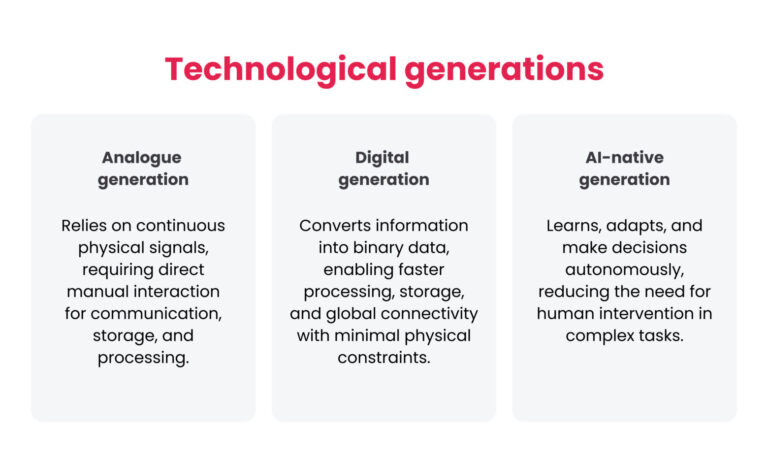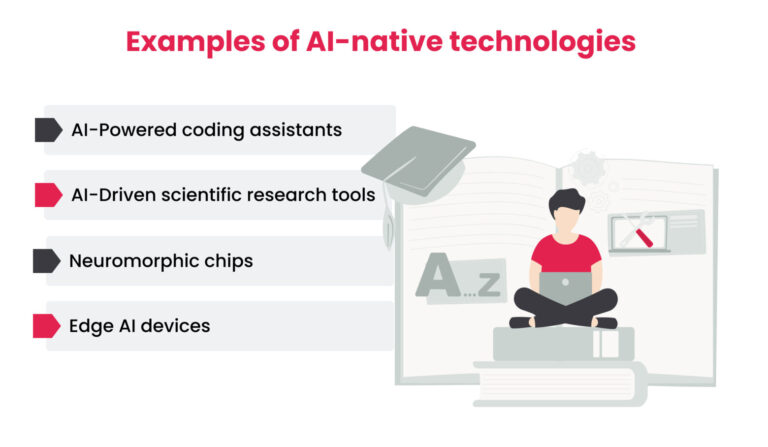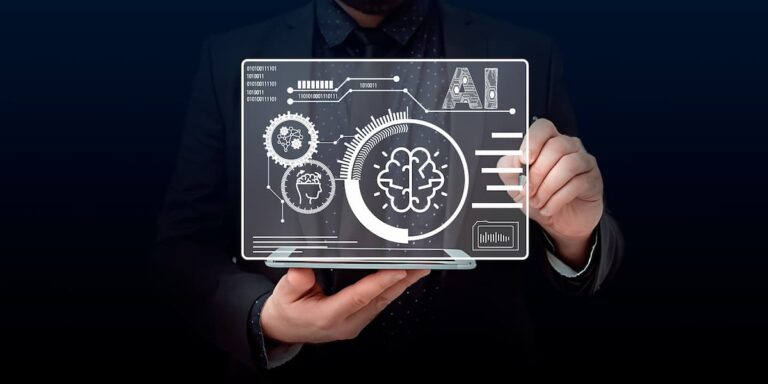Artificial intelligence has evolved to the point where it is no longer just a tool we add to existing systems—it is becoming the foundation of new technologies. In recent years, we have seen the emergence of “AI-native” tools, software with AI at its core instead of integration of AI features or frameworks.
In the ResearchGate article, a professor from IBM Research Center states:
The era of traditional enterprise software, including SaaS, is closing, replaced by the transformative capabilities of AI-native systems. AI platforms are technological advancements and catalysts for a fundamental shift in how businesses operate, innovate, and scale.
Entering new, AI-native era of systems pushes to rethink and reshape how we work, learn, and interact with digital systems.
See also: How generative AI is transforming EdTech
What are AI-native technologies?
“AI-native” refers to technologies, tools, and systems built on top of artificial intelligence. Unlike most AI-based software, these tools are designed to rely on machine learning, automation, and advanced data processing as their foundation.
As Ericsson pointed out in their whitepaper: “An AI native implementation ideally means that AI is implemented as the first thought in the system. The system is designed to leverage AI to achieve zero-touch networks that meet different needs.”
Being a relatively new technology, AI-native solutions have started to show major revenue traction. In their report, Sapphire has stated that close to 47 AI-native solutions on the market generate $25 million in ARR compared to 34 last year.
Using AI at software’s core is the next step in developing new technologies. To understand its impact on the world, we need to understand previous technological generations.
Technological generations
The way humans interact with technology was redefined and improved with each generation. While AI-native systems are the latest advancement, they were built on a strong foundation of past technologies.

Analogue-natives
Before the digital age, analogue-native technologies shaped industries and everyday life. Think landline telephones, vinyl records, and film cameras, as an example. The era’s outliner was the requirement of physical manipulation to get results, such as adjusting a radio dial.
Analogue devices stored and transmitted information through continuous signals. Vinyl records captured sound waves in grooves, while film cameras recorded images on physical reels. Telephones transmitted voices as electrical signals along copper wires.
Interacting with analogue technology required patience and precision. People had to carefully adjust radio dials to find a clear station or rewind cassette tapes. Everything from recording a television program to developing photographs involved time and effort. Despite these limitations, analog systems offered a tactile experience—turning a film camera’s focus ring or dropping a needle onto a record created a direct, hands-on connection with technology.
Digital-natives
With the invention of computers and the Internet, we moved into a digital age. Information could now be stored as precise numerical values rather than continuous signals, leading to improved efficiency and accessibility.
Text, images, and sound could be copied and transmitted without loss of quality, paving the way for mass communication and digital media.
Digital-native users benefited from instant access to information. Instead of waiting for newspapers or television broadcasts, people could read breaking news online. At the same time, software solutions have emerged in the form of desktop, web, and mobile apps.
Music, movies, and books became available at the tap of a screen, eliminating the need for bulky physical collections. However, this convenience also led to information overload, shorter attention spans, and reliance on constant connectivity.
AI-natives
With recent advancements in AI technologies, AI-native solutions have become an everyday occurance. According to McKinsey report, 65% of employers report using AI tools and AI-powered software in their organisation.
AI-native systems rely on machine learning, natural language processing, and real-time data analysis. Unlike traditional digital tools that require direct user input, AI-native systems adapt and optimise based on past interactions. Think AI-driven customer service chatbots, self-learning recommendation engines, and autonomous robots, as an example
AI-native technology aims to reduce friction between users and digital systems. AI-powered assistants can predict what users need, AI-driven applications personalise experiences and automate routine tasks.
Here’s what Jared Spataro, Microsoft’s Chief Marketing Officer has to say.
See also: AI in EdTech: Pros, cons and use cases
Examples of AI-native technologies

AI-powered coding assistants
AI-powered coding assistants, actively debug, and optimise software in real time. Unlike traditional applications, AI-native software is designed to operate autonomously or with minimal human intervention.
These programs rely on machine learning models to make real-time decisions, improve performance, and automate tasks at a level beyond what digital-native applications can achieve.
AI-driven scientific research tools
AI-native research tools can analyse massive datasets, generate hypotheses, and even propose experiments.
These tools accelerate discovery processes by automating data analysis and pattern recognition. They allow researchers to focus on higher-level problem-solving rather than manual data processing.
Neuromorphic chips
Neuromorphic chips mimic the structure of the human brain, processing information in a way that closely resembles biological neurons. This enables machines to learn and adapt in real time while consuming less energy compared to traditional processors.
Edge AI devices
Instead of sending data to centralised cloud servers for processing, AI-native edge devices handle computations locally. This reduces latency and allows real-time AI decision-making, which benefits applications requiring immediate responses, like autonomous vehicles or smart surveillance systems.
See also: Artificial Intelligence vs. Machine Learning vs. Deep Learning: What’s the difference?
Why AI-native systems are important for EdTech
AI-native systems are crucial in education because they tailor learning experiences to individual students. Combined with other EdTech tools, these systems can identify strengths and weaknesses and adjust content and pacing accordingly.
This personalised approach helps students grasp concepts more effectively and keeps them engaged.
AI integration in schools
Schools are increasingly incorporating AI to enhance learning. For example, Willowdown Primary School in Somerset uses AI to generate images from students’ descriptive writing, fostering creativity and discussion. Furze Platt Senior School in Maidenhead engages students with a virtual Charles Darwin to learn about evolution, increasing interest and participation. These initiatives demonstrate AI’s potential to enrich educational experiences.
AI education initiatives
Beijing has made AI education mandatory, even for elementary students. Starting this fall, schools will offer at least eight hours of AI instruction per academic year, aiming to equip students with essential AI skills from an early age. This move reflects the growing importance of AI literacy in modern education.
Conclusion
AI-native technologies are more than just an extension of digital systems—they represent a fundamental shift in how tools, systems, and industries operate.
Unlike past generations that required human-driven input at every stage, AI-native systems are designed to function autonomously, continuously improving their performance through data-driven learning.
As AI-native software continue to evolve, their impact will be felt across every sector, from business and research to education and beyond. This makes becoming AI-driven an obvious choice for anyone looking to stay ahead.
How Altamira can help
Build a custom AI-powered software and leave a meaningful impact on your industry with our stress-free approach.
- Fast results without sacrificing quality. Tools at our disposal ensure a fast development process without quality loss. Visualise your concepts, test your ideas, and get results in days, not weeks.
- Know everything about your project. Get daily, weekly, and monthly updates about your project to ensure you are always up-to-date with the development progress.
- Zero headaches. Our expertise in AI development changes understanding of what’s possible with the technology. Extensive QA testing and best industry practices are the foundation of your successful project.
Get in touch to start developing AI-native tools today.






